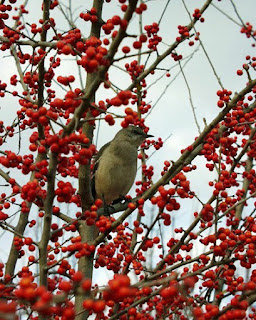We do have many non-native evergreens in our garden, but we find it important to choose native plants whenever possible. After much searching, I have come up with a few suggestions of American native plants you should add to your winter garden:
- American Holly, of course for the berries!
- Pachysandra Procumbens, often referred to as Allegheny Spurge, is a non-invasive groundcover that develops a silvery mottling to its leaves in fall and winter.
- Lonicera fragrantissima begins blooming in January with sweetly fragrant and delicately beautiful blooms. This large growing shrub is commonly referred to as Winter Honeysuckle.
- Evergreens are an important addition to any garden. One I like in particular that looks just as good in winter as any other time of year is Arizona Cypress.
- Yucca provides spikey interest year round and provides contrast in the garden. I like 'Golden Sword' for its bright yellow stripes appearing like sunshine in the garden. The top photo shows Golden Sword Yucca in its January splendor.
.JPG)









